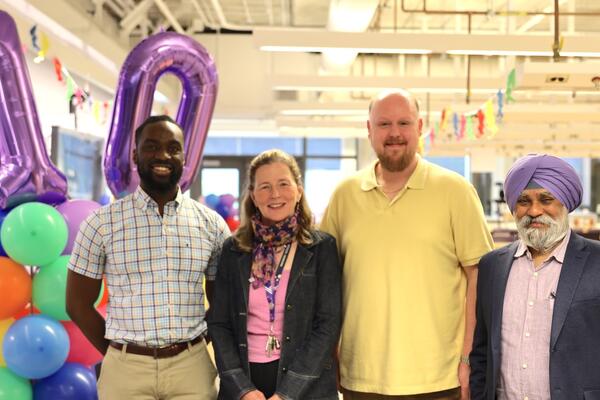
Engineering Outreach: Filling the talent pipeline
Inspiring youth age 7-17 to see engineering as a fulfilling career that makes the world a better place.

Inspiring youth age 7-17 to see engineering as a fulfilling career that makes the world a better place.
By Angela Pause Faculty of EngineeringIt was almost 60 years ago when Canada was in dire need of engineers that Engineering became the first and founding Faculty of the newly formed University of Waterloo. Now, Canada – and the world – is again clamouring for engineers to not only replace the retiring generation, but to lead innovation in emerging technologies. To meet this demand, it’s essential that the engineering talent pipeline be full of diverse, bright and uniquely educated people.
Yet Waterloo Engineering, Canada’s largest engineering school, is not the beginning of the talent pipeline of new engineers. The raw talent for engineering starts much earlier – it begins in the curious and open minds of young children and youth in elementary and high school, says Mary Wells, Associate Dean of Outreach in the Faculty of Engineering and Chair of the Ontario Network of Women in Engineering (ONWie). It’s her job, as well as the dynamic team of staff, students and volunteers she oversees, to help ignite the passion for engineering in young people.
“Inspiring kids to consider engineering first means sparking their curiosity and creating excitement about engineering, science, technology and math,” says Wells.
“While there is a STEM thrust in elementary education, there are no formal or informal programs in elementary or high schools that direct kids towards engineering, so it’s up to Waterloo to be there at the earliest opportunities to get these kids thinking about how cool engineering is and how helpful engineers are in our world.” In a recent well-received TechCrunch article, Wells wrote about how engineers bridge the gap between technology and society.
Motivating kids aged 7-17 to consider an engineering education is something Waterloo Engineering Outreach has done for the last quarter century. Its in-school and on campus programming reaches thousands of students. More than 43,000 youth have had curiosity-provoking experiences at Engineering Science Quest (ESQ) camps alone, plus thousands of in-class engineering workshops or on-campus events created for young women who are considering an engineering education. Its efforts are working: in 2015, female undergraduate enrolment in first year engineering was its highest ever at 28.1 per cent.
“If it wasn’t for the work that Engineering Outreach does in our communities, many of the rural schools would not have access to the calibre of programming we bring to students. Our outreach staff are delivering these interactive modules so the kids actually see university students, perhaps only a decade older than they are, as young professionals interested in science and engineering. It’s mentorship by example as well as giving kids insight on what it’s really like to be in engineering school,” said Wells, noting that last year Outreach visited 50 unique communities and reached 1,250 aboriginal youth with programming.
Waterloo Engineering considers its outreach work critical to its long-term success, so a large space with workshop areas and classrooms on the first floor of the new Engineering 7 building, now under construction, will become Engineering Outreach’s new home in 2018.
“We will be able to offer more programming and activities on campus for young people that will inspire them to see the world of possibilities that engineering offers,” says Wells.

Read more
The Waterloo community comes together to remember, reflect and respond to gender-based violence

Read more
Shop Canadian this holiday season with festive porch plants, fashion-forward apparel, craft spirits and more from Waterloo entrepreneurs

Read more
The Pearl Sullivan Engineering IDEAs Clinic marks a decade of delivering experiential learning embedded in the real world and mentored by industry professionals
The University of Waterloo acknowledges that much of our work takes place on the traditional territory of the Neutral, Anishinaabeg, and Haudenosaunee peoples. Our main campus is situated on the Haldimand Tract, the land granted to the Six Nations that includes six miles on each side of the Grand River. Our active work toward reconciliation takes place across our campuses through research, learning, teaching, and community building, and is co-ordinated within the Office of Indigenous Relations.